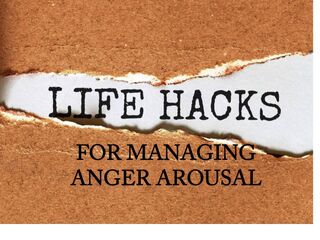Anger
7 Hacks to Reduce Anger Arousal
Several easy strategies can effectively inhibit anger arousal.
Posted October 16, 2020 Reviewed by Ekua Hagan
Anger is a natural emotion that, when listened to, provides us information about ourselves — other feelings, our expectations, and our core desires. Delving into the greater meaning of this message requires pausing for reflection.
Unfortunately for many of us, when in the throes of anger, we may be unable to pause for such contemplation. Ideally, healthy anger entails both being able to effectively manage anger when it arises and understanding the deeper meaning behind it. Such reflection requires taking time, when we are calm, to reflect on your anger. By doing so, we become more connected with ourselves, explore the historical contributions to our anger, and can better understand our hurts and suffering behind it.
However, there are some strategies that can help us to pause even when we may not be fully available to explore our anger more fully. These might be considered “hacks,” strategies that momentarily work around the need for deeper reflection. While such hacks provide little self-understanding of our anger, they can be quite effective to curb its escalation when it does arise.
But it is also important to remember that how, when and in what way we manage our anger, are habits that we have developed over time. As such, even remembering to employ hacks involves time and commitment to rehearse and practice them. The following are several such hacks.
Deep breathing
Deep breathing is perhaps the most well-known and practiced hack for anger arousal. This is because taking several deep breaths and deeply exhaling can ultimately activate the parasympathetic system, which restores the body to a calm and relaxed state. Ideally, inhale through your nose to a count of 4, hold the breath for a moment and then exhale through your mouth to a count of 6. This pattern of breathing has been found to be highly effective in achieving such calm.
For many people, however, this strategy may not work alone, especially when anger is intense. As such, it can be strengthened when accompanied by practicing any or several of the following hacks.
Identify a pair of words to use as a mantra
Identify and rehearse evoking a word-pair that helps to create a pause to reflect rather than react. Examples are Stop or Go, Constructive/Destructive, Red Light/Green Light, and Helpful/Not. Envision these words as a sign, one that reflects color, content, and detail that make it unique for you and can help you remember them. This approach will make them much more memorable than just picturing the words as being on flashcards.

Visualize a positive context
This strategy is primarily effective with a friend, partner, or other family member. When angry, evoke an image of an experience — or several — in which you experienced greater caring or love for that person. This helps diminish the tendency, in the moment of anger arousal, to demonize that person. It helps you to consider the bigger picture, the greater nature of your relationship. In effect, it helps you to experience this bigger picture as dominating your visual field with the current one being placed in the background.
Visualize others as children
I’ve found it helpful to think of all adults as being children, just trying our best to be adults. As such, I find it helpful to envision others as children — often with their adult heads. This image highlights the fact that we are very much influenced by our emotional brain, that we make mistakes and have flaws. Additionally, it reflects the reality that we may impulsively act from our emotional brain without taking time for reflection–a defining quality of children. We all have needs, desires expectations, and fears. And, since the image can be humorous, it competes with and inhibits the physiological response associate with anger.
Further, like children, we may at times be so self-absorbed that we are less able to be empathic with or care about others. Such moments constrict our capacity to reflect and make it more likely that our emotional brain will hijack our feelings, thoughts, and behaviors. Further, when our emotions are dominant, our capacity for clear judgment and reasoning is reduced. This is helpful to remember with regard to our anger as well as in regard to the behavior of others.
Visualize a clear plastic wall between you
Visualize a clear plastic wall between you, just like the ones we have become accustomed to seeing at the check-out cashiers of supermarkets. You may wish to imagine that you are a third party observing the situation through this wall. This imagined barrier can serve as a reminder that you are safe, even when you perceive that you are not.
Recognize unrealistic expectations
All too often, with and without full awareness, we maintain unrealistic expectations that increase our vulnerability to become angry. We have unrealistic expectations of others, the world in general, and ourselves. These include expectations that “Others should behave as I do.” “Life should be fair” “If my partner really loves me (s)he should do _______.” These are often expectations that may exist below the radar of our awareness and are especially inaccessible when we are angry.
As such, it is helpful to have some key phrases — related to these expectations — ready to evoke when anger arises. These can cue us to recognize when they inform our knee-jerk reaction to such events. These might include phrases such as “Nice theory” or “If only“ — as a short-hand response to our expectations that the world doesn’t always follow our blueprint. In keeping with this strategy, it can also be helpful to remember the phrase “Life is” rather than “Life is fair” with regard to expectations.
This requires cultivating mindfulness as part of an ongoing commitment in order to practice it during the moment of anger arousal. In part, mindfulness entails being attentive to where we are choosing to focus our attention in the moment. It also calls for observing our thoughts, feelings, or physical sensations as experiences that we need not embrace. Mindfulness offers us the capacity to step back and observe our internal experiences without being overwhelmed by them. As such, caught up in the moment of anger we could observe our body’s tension including shallow or rapid breathing and an increased heart rate. And we could observe ourselves experiencing anger or thoughts about a triggering event — all without being overwhelmed by our experience.
Make a menu of strategies
It’s one thing to be familiar with these hacks but another to be alert to engage them during moments of anger arousal. Really cultivating them as part of a knee-jerk “go-to” response, calls for making them easily accessible to your attention.
One of the most meaningful ways to do this is to write a menu consisting of these hacks and any others you find to be effective. Place the list in a place that can be easily and frequently observed. Instead of entering them in your cell phone or as a file on your computer, you may want to write them on Post-it notes or a whiteboard that you can view daily. In this way, you will repeatedly see them and — by doing so — make them a part of your ongoing awareness. Practice them with even the slightest intensity of anger — even with low-level annoyance. The more opportunities you take to engage them, the more they will become an automatic part of your repertoire. Each time you practice them, you will cultivate them as your new automatic response when faced with the challenge of anger arousal.




